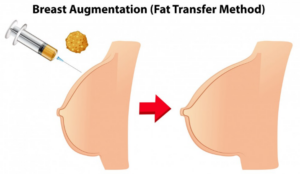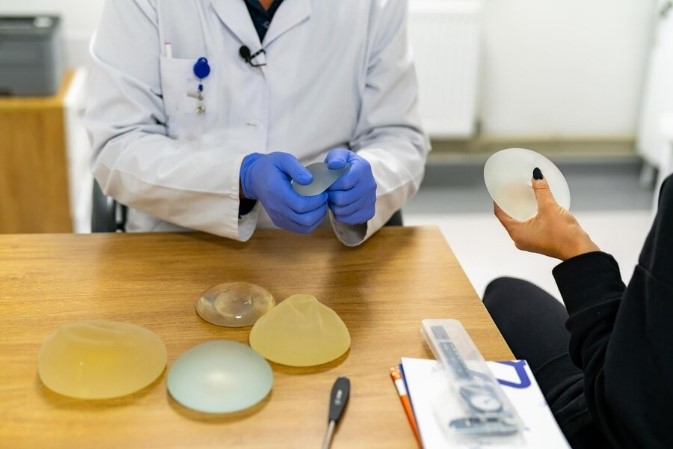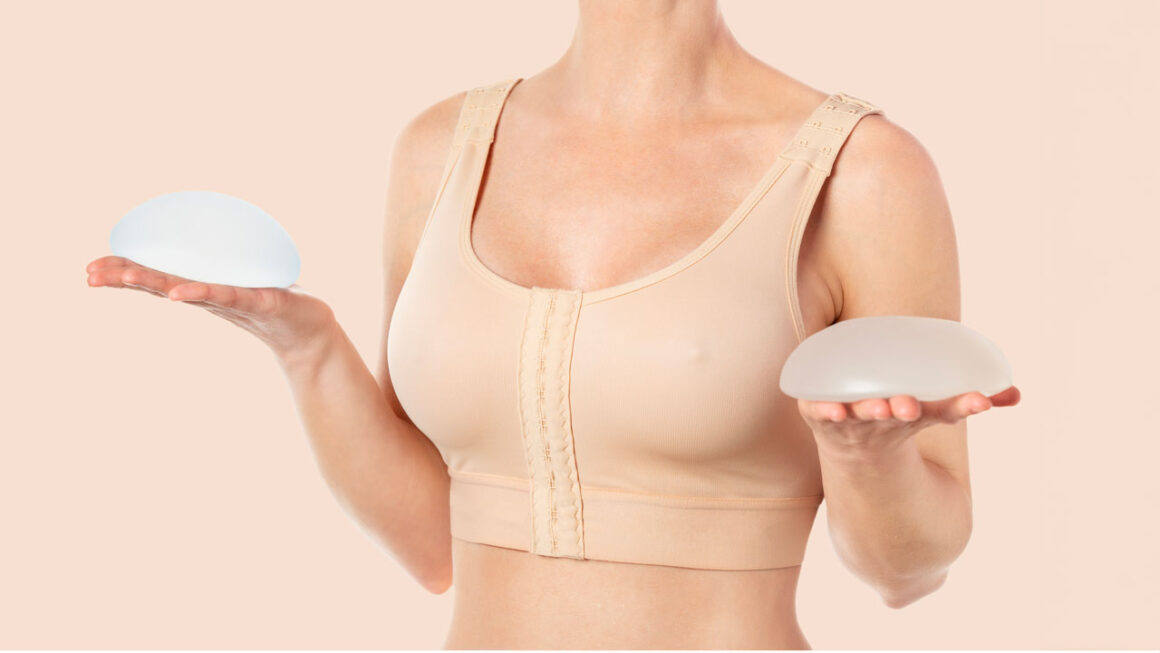Breast augmentation surgeries are operations that change the size and shape of the breast.
Breasts may grow disproportionately during puberty, one may be smaller than the other. Even if a woman was satisfied with her breasts in the past, now she may feel uncomfortable because they have lost their fullness due to weight gain, breastfeeding or aging, their shape has changed, and therefore they begin to look different.
In these cases, women can have natural-looking breasts that are more compatible with their body shape by correcting the shape and size of their breasts with breast augmentation surgery.
 When deciding how much to enlarge the breast, the desire of the person, the current situation and the dimensions of the rib cage are taken into consideration. Two methods are used in breast augmentation surgery. One of them is fat injection into the breast, known as ‘lipofilling’, and the other is breast implants, also known as ‘prosthesis’, which is still the most popular method.
When deciding how much to enlarge the breast, the desire of the person, the current situation and the dimensions of the rib cage are taken into consideration. Two methods are used in breast augmentation surgery. One of them is fat injection into the breast, known as ‘lipofilling’, and the other is breast implants, also known as ‘prosthesis’, which is still the most popular method.
The breast implants used are silicone prostheses. Silicone prostheses do not react with any tissue after being placed in the body and their molecular structure does not change. As a result of technological developments, the structure, softness, durability and shape of silicones have enabled natural results to be obtained in breast augmentation surgeries.
 The choice of the prosthesis to be used is made according to the patient’s expectations, breast structure, rib cage shape and soft tissue thickness, as a result of the preoperative physician’s evaluation. Again, the physician and the patient decide together on issues such as the entry site of the operation, the placement and dimensions of the prosthesis.
The choice of the prosthesis to be used is made according to the patient’s expectations, breast structure, rib cage shape and soft tissue thickness, as a result of the preoperative physician’s evaluation. Again, the physician and the patient decide together on issues such as the entry site of the operation, the placement and dimensions of the prosthesis.
Prosthesis alone may not be sufficient in breasts that have lost their fullness, that are loosened and that are severely sagging. In this case, breast lift surgery should be performed in addition to prosthesis application.
The results of breast augmentation surgery depend on many factors. Factors such as the current size of the breasts, the diameter of the breast base, asymmetric development of the breasts, sagging in the breast, the shape of the chest wall, the elasticity of the skin and deformities in breast development may affect the outcome of the surgery. Pregnancy and aging may cause some changes in postoperative appearance.
What is breast augmentation surgery?
These are surgeries that change the size and shape of the breast by applying fat injection or breast implants to the breast.
Why is breast augmentation performed?
Breast augmentation surgery is performed to correct the shape and size of the breasts, which have lost their fullness due to weight gain, breastfeeding or aging, have changed their shape, and therefore cause discomfort because they have a different appearance, to give a more harmonious appearance with the body.
What is the best age for breast augmentation?
People over 18 years of age can undergo this surgery. There is no upper age limit.
Am I a good candidate for breast augmentation?
If one of the following applies to you, you may be a candidate for breast augmentation surgery;
- If you complain that your breasts are small,
- If your clothes do not fit the hips and chest area in the same harmony,
- If you feel uncomfortable wearing bikinis and tight clothes,
- If your breasts have lost their fullness and decreased in size after birth,
- If the shape and size of your breasts have changed after losing weight,
- If you have asymmetry between your breasts.
What should I do before the surgery?
Before breast augmentation, breast ultrasound is performed if you are under 40 years old, and mammography and breast ultrasound are performed if you are over 40 years old.
Your physician takes a detailed story. Your general health condition, drug allergies, operations you have undergone until that day – for example, breast biopsy – and treatments are questioned. A breast examination is performed before the operation. The volume and shape of your breasts, the structure of your skin and the location of your nipples are examined. Photographs will be taken.
Blood thinners, aspirin, painkillers containing ibuprofen, flu medicationes and contraceptives should not be used for at least 1 week before surgery. It is also recommended to discontinue substances known to dilute blood such as vitamin E, fish oil, ginseng, green tea, herbal teas, flaxseed.
Smoking and alcohol should be stopped at least 1 week before the operation.
Step by step operation process:
Anaesthesia: General anaesthesia is applied.
Surgical procedure: The surgical incision is most commonly made in the inframammary fold, less commonly in the lower part of the nipple or in the armpit area. The room for the prosthesis can be prepared in front of the pectoral muscle (i.e. just behind the breast tissue) or behind it. The dual plan technique, which is a combination of these two techniques, can also be used. The entry site is closed with absorbable suture materials.
What should I expect after breast augmentation surgery?
 After the surgery, a small bandaging is applied and a surgical bra is worn to provide breast support.
After the surgery, a small bandaging is applied and a surgical bra is worn to provide breast support.
Breast augmentation surgery is not a painful surgery. Mild to moderate pain that may occur afterwards responds well to simple painkillers.
In the early period, there may be swelling, numbness in the nipple and mild bruising. These disappear spontaneously in a short time.
There is a minimal scar at the incision site that can be easily concealed.
What should I pay attention to after breast augmentation surgery?
You can take a shower on the 2nd day.
Home rest is recommended for the first 3 days.
Bandages are removed on the 3rd postoperative day.
You should not smoke for one week after the operation.
Aspirin should not be taken for 3 weeks due to its bleeding-enhancing effect.
Surgical bra is used for 3 weeks.
Weight lifting and exercises using arms should be avoided for 3 weeks.
Light sports can be started as of the 3rd week.
Stitches do not need to be removed because they dissolve spontaneously. Since hidden sutures are applied, the incision scar on the skin surface is minimal.
When can I return to work after breast augmentation surgery?
You can return to work one week after the operation.
What is the recovery time after breast augmentation surgery?
It is possible to return to normal life completely at the end of one week.
What results should I expect after breast augmentation surgery?
Factors such as the current size of the breasts, the diameter of the breast base, asymmetrical development of the breasts, sagging breasts, the shape of the chest wall, the elasticity of the skin and deformities in breast development can affect the result of the surgery.
It may take 6-9 months to finalise the appearance after breast implant.
Rapid weight gain and loss, breastfeeding and the aging can cause changes in breast fullness and shape. The results of breast augmentation surgery depend on many factors.
How long does a breast prosthesis last?
Thanks to technological developments, silicone prosthesis has now gained features that can last a lifetime. The possibility of any wear, tear and deformation in the silicone prosthesis over the years is negligible.
Does the risk of cancer increase after breast augmentation surgery?
Various researches have been carried out on this subject all over the world for years. These studies have repeatedly proven that breast prostheses do not increase the risk of cancer in any way.
Frequently Asked Questions
It is not possible to actually increase breast size with exercise. However, strengthening the rib cage muscles with exercises caused breasts to stand more upright.
Two methods are used in breast augmentation surgery. One of them is fat injection into the breast (Lipofilling) and the other is breast implants (Prosthesis), which is still the most popular method.
The most common method for breast augmentation is silicone implants. To a lesser extent, fat injection is also used.
Breast augmentation with implants has become one of the most popular surgeries in the last 10 years
Breast augmentation surgery allows you to have fuller and properly shaped breasts. It can be performed with two different methods by fat injection into the breast or by placing a prosthesis, i.e. implant, into the breast.
There are different types of implants according to their content, shape and surface characteristics. According to their content, those filled with serum or silicone gel are the most commonly used. According to their shape, they can be round or drop-like. According to their surface, they can be smooth or rough. These new generation implants are very resistant to pressure and impacts. They do not need to be replaced over time or for reasons such as pregnancy. For this reason, they are called ‘Life Time’, that is, ‘lifelong silicones’. Today, two types of Life Time implants are used. One of them is round and the other is drop-shaped silicone implants. With round silicones, the upper side of the breast looks fuller. Drop-shaped silicones, on the other hand, lift the breast more from the bottom and give the person a completely natural appearance. Life Time implants are almost the consistency of normal breast tissue. Thus, both the sense of touch is natural and the movement of the implants with the body appears normal.
With round implants, the upper side of the breast looks fuller. Teardrop-shaped silicones, on the other hand, lift the breast more from the bottom and give the person a completely natural appearance.
Drop-shaped silicones lift the breast more from the bottom and give the person a completely natural appearance.
Life Time implants have almost the consistency of normal breast tissue. Thus, both the sense of touch is natural and the movement of the implants with the body appears normal.
There is no scientific data showing that breast implants increase the risk of breast cancer.
After your physicians’s examination, the most suitable breast implant is determined together with you, taking into account your body measurements, the shape of your rib cage and your expectations. Between 100 ml and 800 ml breast implants are available.
The largest breast implant has a volume of 800 ml. Those between 400 ml and 800 ml are considered large breast implants.
If the shell that naturally surrounds your breast implant thickens, the implant may become stuck and dislocate. In this case, your implant will be replaced with a new operation. However, this situation is very rare. In cases of skin laxity, asymmetry, sagging and insufficient breast tissue after breast implant removal, an additional surgical intervention may be required.
After your physician’s examination, the most suitable breast implant is determined together with you, taking into account your body measurements, the shape of your rib cage and your expectations.
Laxity, asymmetry and sagging of the skin may develop after breast implant removal. In addition, there may not be enough breast tissue left. In these cases, an additional surgical intervention may be required.
The lower age limit for breast implants is 18 years. There is no upper age limit.
The most suitable prosthesis for you is selected after your physician’s examination. The most important criterion at this point is your physical characteristics. Your age, height, shape of your rib cage, breast shape and size and your preference are taken into consideration.
Being at the ideal body mass index allows a better evaluation of your body shape, rib cage structure, actual breast size and shape. Under these conditions, it is healthier in order to determine the most suitable prosthesis for you.
Silicone implants are the most reliable and best implants.
The implants harden if the shell that naturally surrounds your breast implant thickens.
The breast implants used today are made of silicone. Silicone is also an inert material, i.e. it does not react with tissue. Therefore, implant rejection is out of the question.
Only if the shell that naturally surrounds your breast implant thickens, the implant may become stuck and dislocate. In this case, your implant will be replaced with a new operation. This situation is very rare.
Breast implants are not affected by your weight gain. However, weight gain and loss can negatively affect the appearance obtained after breast augmentation surgery.
The method of breast augmentation without implants is fat injection. The fat taken from your own body, usuaaly the abdominal fat, is specially prepared and applied to the breast.
Silicone implants produced with the latest technologies have the chance to be used for a lifetime.
Since these new generation implants are very resistant to pressure and impact, you can use them for a lifetime without any problems.
Yes. Fat injection is one of the methods used for breast augmentation.
No, you cannot. Fat injection is considered a tissue transplant. However, you can use specially prepared fat taken from your own body for breast augmentation.
Breast fat transfer takes 1.5-2 hours.
Apart from prosthesis, fat injection is applied for breast augmentation. Fat cells taken from one’s own body, usually from the abdominal region, are specially prepared and injected into the breast.
Yes. If fat injection is to be performed for breast augmentation, the person’s own fat cells are used.
Fat cells taken from different parts of the body are injected into the breast after being specially prepared.
Yes, you can. The fat aspirated from the abdominal area is injected into the breast.
Depending on the condition of your breasts, 150-400 ml of fat can be transferred
It takes 1.5-2 hours to transfer fat to the breasts.
No, it is not. Liposuction is performed first. This is done under general anaesthesia. Therefore, no pain is felt.
Yes. Bras that are not tight and without underwire are recommended. Sports bras are generally preferred.
You should sleep with the upper body upright and without any pressure on the breasts.
You can exercise after 2 to 3 weeks.
You can return to your normal life after 4 to 5 days.
Although at a very low rate, bleeding, oedema, asymmetry in the breasts may be observed.
Fat injection is one of the two techniques used in breast augmentation surgery.
In fat transfer obtained by liposuction, it is 60% permanent, and if stem cell transfer is also performed, it is 75% permanent.
If the fat to be transferred is obtained by liposuction, it is 60% permanent, and if stem cell transfer is also performed, this is then 75% permanent.
Although it varies from person to person, up to 60% of the fat injected into the breast remains.
Breast augmentation achieved with silicone implants is more permanent than autologous fat injection.
After your physician’s evaluation, the appearance of your breast will be shared with you by 3-D simulation method.
Before breast augmentation, breast ultrasound is performed if you are under 40 years of age, and mammography and breast ultrasound are performed if you are over 40 years of age.
Blood thinners, aspirin, painkillers containing ibuprofen and flu medications should not be used for at least 1 week before surgery. It is also recommended not to use substances known to dilute blood such as vitamin E, ginseng, green tea, herbal teas, flaxseed. Smoking should be stopped at least 1 week before the operation.
Breast augmentation surgery is performed under general anaesthesia.
Sagging of the breast is a natural process due to aging no matter if you have a breast implant or not. However, since implants poses a greater weight on the breast, this might cause a more sagging appearance.
Yes, since the operation is performed under general anaesthesia, a breathing tube is inserted.
One of the two methods used in breast augmentation surgeries is breast implants and the other is fat injection into the breast.
Changes in sensation in the nipple may occur because the breast implant causes tension on the nerves leading to the nipple. Numbness in the nipple often regresses in the first 3 months. Rarely, it may take up to 1-1.5 years for the sensation to return in the nipple.
Problems such as bleeding, infection, delayed wound healing or asymmetry are very rarely seen after breast augmentation surgery performed by an experienced plastic surgeon at modern equipped hospitals. The body surrounds the breast prosthesis with a shell. If this shell thickens, the prosthesis may be squeezed and displaced and the prosthesis may need to be replaced with a new operation, although rarely.
Life Time implants have almost the consistency of normal breast tissue. Thus, both the tactile sensation is natural and the movement of the implants with the body appears normal. However, birth, breastfeeding, weight gain, weight loss and ageing can adversely affect the postoperative appearance.
Beast augmentation with implant is one of the most popular surgery in tha last ten years, due to liability of the implant and the surgical improvements. Since the surgery is painless and takes only one to two hours, it has become the most preffered method.
As a natural consequence of aging, sagging develops in tissues. Whether you have implants in your breast or not, it will still sag a little with age.
Although pregnancy, breastfeeding and aging can negatively affect the result of surgery, the appearance of the breasts is generally long-lasting.
There is no scientific evidence that breast implants increase the risk of breast cancer.
New generation implants do not soften.
Mild to moderate pain after surgery responds well to simple painkillers.
It is not correct to say that breast augmentation surgery is a painful surgery.
It is not correct to say that breast augmentation surgery is a painful surgery.
Yes, you should. Surgical bras accelerate the healing process. If you do not use these bras or stop using them before the recommended time, your breast implant cannot fully adapt to its new shape and size. Therefore, it may slip out of place.
3 weeks after the operation, you can stop wearing the surgical bra and switch to a support bra without underwire. You should wear this bra day and night for 2 weeks. However, you can only not wear a bra 6 weeks after surgery.
4 weeks after the operation, you may stop wearing a bra at night.
Breast massage can be applied for up to 6 months, starting one month after the operation, as recommended by your physician.
It is not recommended to raise your arms above shoulder level for at least 2 weeks after surgery. You should not lift anything heavy for 6 weeks. You should not carry anything heavier than 5 kilos before 3 months.
It is recommended to wait 2 weeks to wash your hair on your own.
In general, you can drive as soon as the use of painkillers is over and you feel comfortable behind the wheel. This can take from a few days to a week.
Driving in the early recovery period can cause pain and dislocation of the breast implant.
It is recommended that you sleep upright after breast augmentation surgery.
You should sleep in an upright position for at least one to two months (on average 6 weeks) after the operation. In this way, there will be less pressure on the incision site and implant and swelling will regress more quickly.
It is recommended to sleep on your back for 1 to 2 months after the operation.
For the first month or two, it is recommended to lie on your back and upright at an angle of 30-45 degrees. However, you can sleep on your side after 6-8 weeks (approximately 2 months).
It is not recommended to lie on your side for the first 6-8 weeks. During this period, wound healing is completed and you do not risk having problems with your stitches. In addition, since the implant placement process is still very new, you will cause asymmetric pressure on the implant by lying on your side.
You can take a shower on the 2nd day after the operation.
You can do push-ups 4 weeks after the operation.
Swimming is not recommended for the first 4 weeks.
2 weeks after the operation, you can start running at a light to moderate cardio pace.
Full recovery can take up to 4 weeks.
For breast augmentation surgery after childbirth, it is recommended that you wait until you stop breastfeeding and reach the ideal weight you want.
Breast implants do not interfere with pregnancy or breastfeeding, as the breast itself is not cut off in breast augmentation surgery.
The first 4 weeks after the operation is the most important time for the implant to settle into place. During this period, the chest muscles should not be forced to work. Therefore, one should not lift more than 5 kg, carry heavy back/side bags, open and close car doors for the first 4 weeks. Avoid exercises that will strain the back and rib cage muscles. For example, exercises such as golf, tennis, push-ups, pilates, yoga, swimming can be done after 4 weeks.
You can return to work one week after the operation.
Implants do not interfere with breastfeeding regardless of their placement.
Mammograms with prosthetic breasts may require special techniques. However, your routine breast screening should continue as recommended in the guidelines.


Leave a Reply
You must be logged in to post a comment.